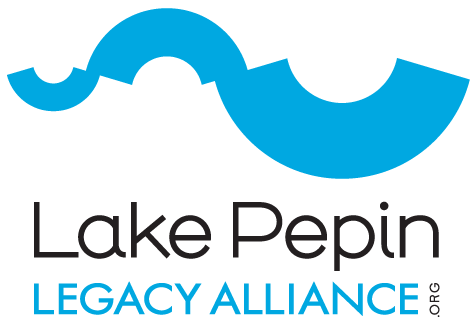Contact: Mac Becco, LPLA Communications Director at mac.becco@lakepepinlegacyalliance.com
Lake Pepin is filling in to the point that the upper part of the lake could be gone within a century. Much of that sediment filling in the lake comes from the Minnesota River upstream.
Phosphorus is also a concern for Lake Pepin. Excess phosphorus can lead to severe algae that is detrimental to aquatic life and recreation such as fish and swimming.
The Minnesota Pollution Control Agency and local partners recently released studies that address both sediment and phosphorus that affect Lake Pepin.
One study calls for a 50-percent reduction in sediment in the Minnesota River to improve its water quality and downstream waters. This study is open for comment through Sept. 20.
A second study addresses excess nutrients that can lead to severe algal blooms in Lake Pepin. This study has led to limits on phosphorus discharges from wastewater treatment plants to prevent severe algae, even as populations and wastewater discharges increase. This study is open for review with a formal comment period to follow later this year.
To help area residents learn about the studies, and how they can provide input on them, the Lake Pepin Legacy Alliance (LPLA) is hosting an open house from 4-7 p.m. Thursday, Aug. 29, at the Lake City Sportsmen’s Club, 2200 S Oak St, Lake City, MN 55041. The MPCA will provide formal presentations at 5:30 p.m., though people may stop in at their convenience to visit with the scientists and ask questions.
(The event will include complimentary snacks and a cash bar.)
Both studies, funded by the Legacy Amendment, determined the Total Maximum Daily Load (TMDL) or the maximum amount of pollutants that a water body can accept and still meet water quality standards. The standards are designed to make sure waters are fishable and swimmable.
The sediment study focused on Total Suspended Solids – sediment and other particles that cloud the water – in the main portion of the Minnesota River and its tributaries in the Greater Blue Earth River basin.
The Minnesota River basin is a naturally vulnerable system with erodible soils, but some practices such as artificial drainage worsen the situation by bringing too much water at too fast a rate into the system. Increasing flows are a major factor in the Minnesota River basin, accelerating erosion of river banks, reducing water quality and threatening infrastructure.
In the last 80 years, flows have doubled in the Minnesota River. While increasing precipitation plays a role in higher flows, so do increased artificial drainage, loss of wetlands and other water storage on the land, and lack of perennial vegetation. The end result is erosion of fields and streambanks that send sediment into the water.
The muddy water then makes it hard for fish and other aquatic species to breathe, find food and reproduce. The sediment is also filling in the Lower Minnesota River and Lake Pepin downstream at a much faster rate than before European settlement – and intensive farming – of the basin.
While many producers have implemented practices to keep soil on the land and out of rivers, more changes are needed across the 10 million acres of the Minnesota River Basin, where 80% of the land is used for agriculture.
In addition to the Minnesota River, the Upper Mississippi and St. Croix river basins drain to Lake Pepin, meaning nearly 50,000 square miles drain to the lake. The study on excess nutrients examined the impact of those river systems on Lake Pepin. Altogether, the following reductions in phosphorus are needed for Lake Pepin to meet water quality standards:
· 20-percent reduction from the Mississippi River at Ford Dam (Lock & Dam 1)
· 50-percent reduction from the Minnesota River
· 20-percent reduction from the St. Croix River
· 50-percent reduction from the Cannon River
· 20-percent reduction from other tributaries
Most of those reductions will need to come from indirect phosphorus sources such as cropland. Several conservation practices reduce phosphorus in runoff and drainage, including water retention areas, improved fertilizer management, and perennial crops.
The study also identified a 70%-reduction in phosphorus from wastewater treatment facilities, which they have nearly achieved already.
To learn more about the studies:
· Visit the Minnesota River Basin portal on the MPCA website at www.pca.state.mn.us/water/minnesota-river-basin. In addition to the Minnesota River and Greater Blue Earth River study, several others are on public notice that address pollutants thoughout the basin.
· See the draft Lake Pepin TMDL report at www.pca.state.mn.us/water/tmdl/lake-pepin-excess-nutrients-tmdl-project.
After their formal comment periods, the MPCA will revise the studies according to input received and then submit them to the U.S. Environmental Protection Agency for final approval.
#

